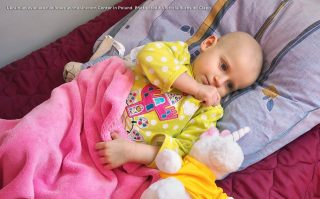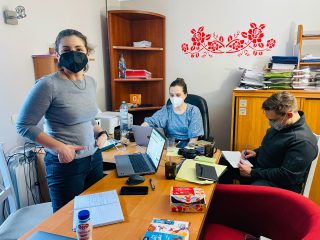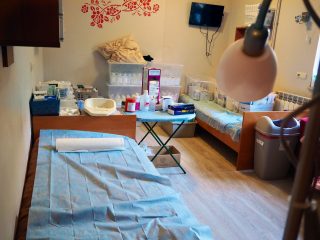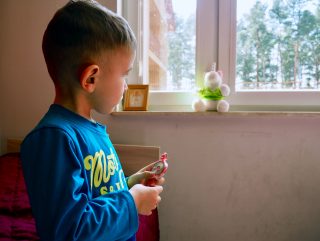
Long established St. Jude global partnerships speed evacuation of Ukrainian kids
St. Jude Global has worked for years with Ukrainian partners, others across globe to save more kids with cancer, enabling rapid, mass humanitarian response.

March 18, 2022 • 7 min

Dr. Asya Agulnik of St. Jude Children’s Research Hospital doesn’t remember if the first request was by text or phone. It felt like she’d had constant conversation with frantic partners in Ukraine as the Russian invasion began.
But the plea was clear and urgent: Could St. Jude help?
St. Jude and ALSAC, its fundraising and awareness organization, had never undertaken such a massive, logistical operation – coordination of a complicated evacuation of critically ill children with cancer during a war.
The answer was yes. But it couldn’t do it alone.
In the three weeks since, St. Jude has leaned on long-established global partners in the region and sought help from dozens of advanced pediatric treatment centers throughout Europe and North America. Known as SAFER Ukraine, the humanitarian effort launched following the Russian invasion to provide safe passage for childhood cancer patients and their families out of Ukraine.
More than 600 children are known to have been evacuated or to be in the process of being evacuated through the SAFER Ukraine effort so far – some kids and their families may arrive at St. Jude within days - and the orchestrated convoys continue, bringing more sick children out of Ukraine, into Poland, then to an ever-expanding network of hospitals.

Dr. Asya Agulnik (left) of St. Jude Children’s Research Hospital. Photo credit Victoria Burnside Clapp.
Within hours of that initial plea for help, a virtual command center at St. Jude and ALSAC headquarters was established to manage information and coordinate with partners on the ground in Ukraine and beyond. It became the operational bridge for both hospital and foundation partners trying to save children halfway across the world and get them to safety, and treatment, wherever possible.
What began as a single Zoom call that was open 24 hours a day quickly evolved into a large team that worked in shifts with breakout rooms and staff rotating in and out. Doctors, administrators, translators, shift leads, executive leaders, foundation partners and experts. Anyone with a question:
How were children getting out of the country? Who would house them? Care for them? And who would pay?
St. Jude is the only World Health Organization (WHO) Collaborating Centre for Childhood Cancer and has 182 partners in 61 countries, including Ukraine and Poland. It is aggressively pursuing several programs simultaneously to improve survival rates across the developing world – from 20 percent currently to a goal of 60 percent by then end of the decade for six of the most common forms of childhood cancer. U.S. survival rates top 80 percent.
To meet that global survival goal, St. Jude, in partnership with WHO, recently announced the Global Platform for Access to Childhood Cancer Medicines, which will provide a consistent, quality supply of chemotherapy and other medicines in dozens of countries during a pilot phase – all without charge to the participating countries. It’s a $200 million investment paid by St. Jude donors expected to help an estimated 120,000 kids in its first five years.
But those programs are aimed at improving care locally so more of the estimated 400,000 kids around the world with cancer each year, the vast majority in the developing world, nearly half never diagnosed, can be treated in their home countries while receiving U.S. equivalent care.
That model changed literally overnight in Ukraine because of the constant bombardment by Russian troops. The global network transformed into an evacuation effort in a country the size of Texas with a population as big as California.
It might not have happened without St. Jude and ALSAC’s existing relationships with hundreds of doctors, nurses, clinics, hospitals and foundation partners across the region.
A lot of these stakeholders … they’re putting trust in us to do what’s right for these patients and make smart and wise decisions in a coordinated way,” said Dr. Agulnik, director of the Eurasia regional and global critical care programs within the St. Jude Global initiative who is on the ground at the Unicorn Center in Poland.” And without those preexisting relationships, in a time of war, I think that wouldn’t have happened so quickly. Maybe it wouldn’t have happened at all.”
In just three weeks, partners in Ukraine and Poland have arranged buses, trains, cars and ambulances on both sides of the border to transport children and their families to safety throughout Europe and Canada – and soon to the United States.
Partners in Poland, the Herosi Foundation, arranged the use of a former 190-room hotel that has been converted to a triage center called Unicorn Marian Wilemski Clinic in Poland. The young patients are medically evaluated, fed, provided rooms to rest and recover from their harrowing trip through Ukraine and across the Polish border, before they’re sent elsewhere for treatment. The Polish Society of Pediatric Oncology and Hematology provides the center licensed practioners.
Building on decades of global work through its international outreach program, in 2018, St. Jude Global was formed to target the 20 percent global childhood cancer survival rates mirroring those in the U.S. when St. Jude opened in 1962. The collaboration has partnerships with regional programs and individual clinics, hospitals and foundation across seven global regions, including Eurasia.

Triage room at the Unicorn Center in Poland. Photo credit Victoria Burnside Clapp.
Clinicians in the program have worked on six priorities across the region, including education, patient care, health systems, research, nursing, and acute lymphoblastic leukemia treatment strategies.
They worked to create regional training opportunities, build capacity for pediatric palliative care, map pediatric hematology-oncology services and the development of early diagnosis strategies, and implement pediatric cancer registries across the region.
In 2020, St. Jude invited Ukraine to participate with Mongolia and Sri Lanka in the rollout of a tool called C5: the Country Collaboration for Childhood Cancer Control.
It brought people of different perspectives together to facilitate national strategic planning to improve the care and cure of children with cancer. The idea was to see how partners could prioritize childhood cancer needs while still recognizing the broader needs for children with chronic diseases – and anything else that might be on the government’s plate.
“It’s important to understand how and where the decisions are being made or updated for, say, which medicines are considered essential or which diagnostics would be covered by the government or to recognize how children may be referred or transferred between different regions,” said Dr. Catherine Lam, director of the St. Jude Global Asia Pacific Regional program and Global Health Systems Unit who created the C5 tool.
Ultimately, the Ukrainian team settled on programs in three areas – workforce, service delivery and information systems – that they thought would have the most impact on the survival of children with cancer in their country.
But when Russian bombs fell on Ukrainian cities three weeks ago, all work on those projects stopped. The focus shifted solely to evacuating children because it was impossible for care to continue inside the war zone. Hospitalized children were moved to basements and bomb shelters until they could be moved to safety.

Ukrainian evacuee Taras looks out a window at theUnicorn Center in Poland. Photo credit Victoria Burnside Clapp.
When that time came , the relationships forged with St. Jude during all those years of research, collaboration and vigorous debate, made it easy for the Ukrainians to ask for help.
“We know their families. We’ve met them. We’ve spent time with them. We’ve strategized with them. We’ve done research projects together,” said Dr. Agulnik “And it’s that individual connection over and over and over again among all of the key stakeholders that, I think, allows in this very critical, stressful time for them to feel comfortable relying on us.”
In addition to clinical collaborations, ALSAC, the largest healthcare charity in the world, taught its global counterparts how to raise awareness of their cause and their own money according to local customs and culture and provide sustainable resources to the pediatric oncology patients it supports. ALSAC provides everything from leadership training and technology, business and marketing infrastructure insights to training in basic fundraising to peer counseling on larger events and campaigns such as galas and radiothons.
It was on that foundation, the urgent work to evacuate sick children, and their families, began, said Natalia Wobst, ALSAC senior regional lead, Eurasia.
“Over three weeks, we have come to see those initial humanitarian plans materialize, families housed and fed, patients transferred and placed in clinics where they can continue their care, even as the situation on the ground becomes more acute. All along the way, we have checked in to make sure operationally they had what they need to execute plans that were far beyond their original means,” Wobst said.
Yuliya Nogovitsyna, program director for Tabletochki Foundation, is confident the evacuated children her organization serves will get the best care.
We would not be able to do this on our own for, sure. So many people, so much infrastructure is involved, both from St. Jude and ALSAC.”
That starts from the moment a family or hospital calls the foundation with a request to evacuate a child. The foundation obtains medical records, and St. Jude with the help of volunteers translates them. Tabletochki staff arrange safe transport to the western city of Lviv, where St. Jude clinic partners evaluate the patients and then organizes them in convoys to cross the Polish border.
Once there, the children are triaged at the Unicorn Center and sent to hospitals with the best pediatric oncology programs in Europe – Poland, Germany, Spain, the Netherlands, Canada and soon to the United States – all facilitated by St. Jude.
“The biggest thing is the trust they are placing in us to literally pass their patients over into this system and then trust that they would be well taken care of, as if they were our patients,” Dr. Agulnik said. “I think that’s a big thing. It’s a big step to say, ‘We can no longer take care of these patients locally,’ and to ask for help, especially in a time of crisis like this.”
It’s impossible to know how long the evacuation efforts will last.
“While we have a sense of the total number of patients, we don’t know how many of them have safely crossed the border without our help or maybe even crossed into Russia where we have no information and then how many are not able to leave because of some social issues or safety concerns,” Dr. Agulnik said from Poland. “And so, that’s where it’s really hard to know where the end goal is or when the stream of patients will stop.
“But we are available, and we have capacity to take as many patients as come.”
–
We know our partners, patients and their families appreciate your care and concern during this very difficult time. We continue to work around the clock to ensure our partner foundations have the resources to help affected families receive lifesaving treatment and care.
For more information about the Tabletochki Foundation, visit https://www.globalgiving.org/projects/war-in-ukraine-help-children-with-cancer
For more information about the Herosi Foundation of Poland, visit http://herosi.eu/sposoby-pomocy/#4. ** Given the wartime situation, the Herosi Foundation also directs donors to Paypal.



